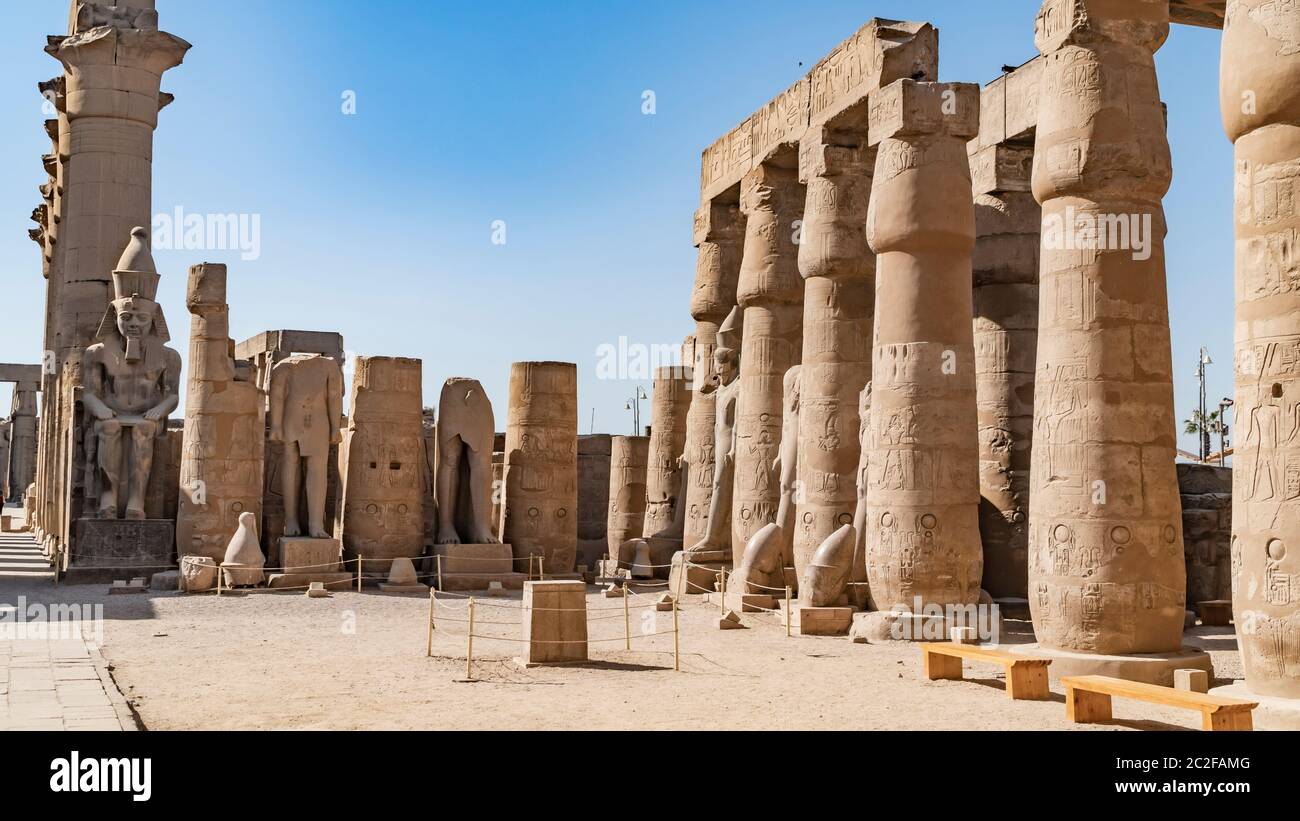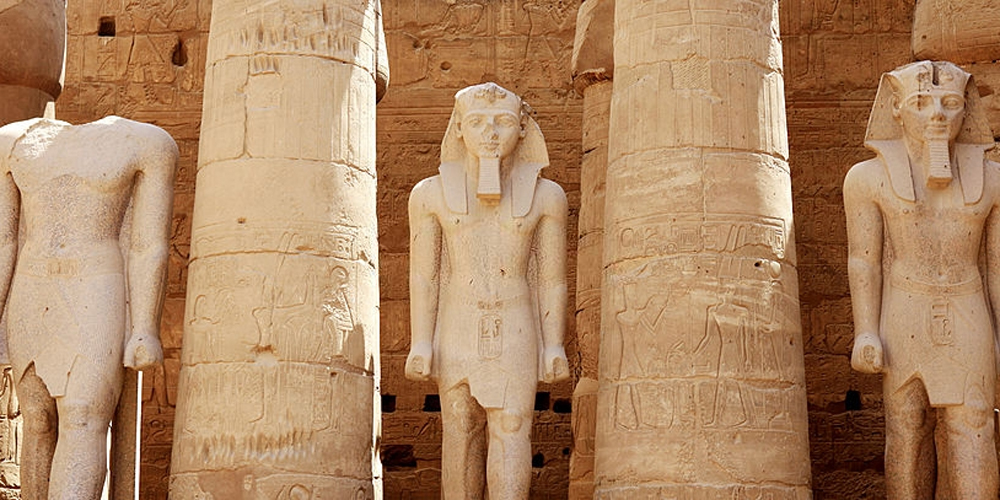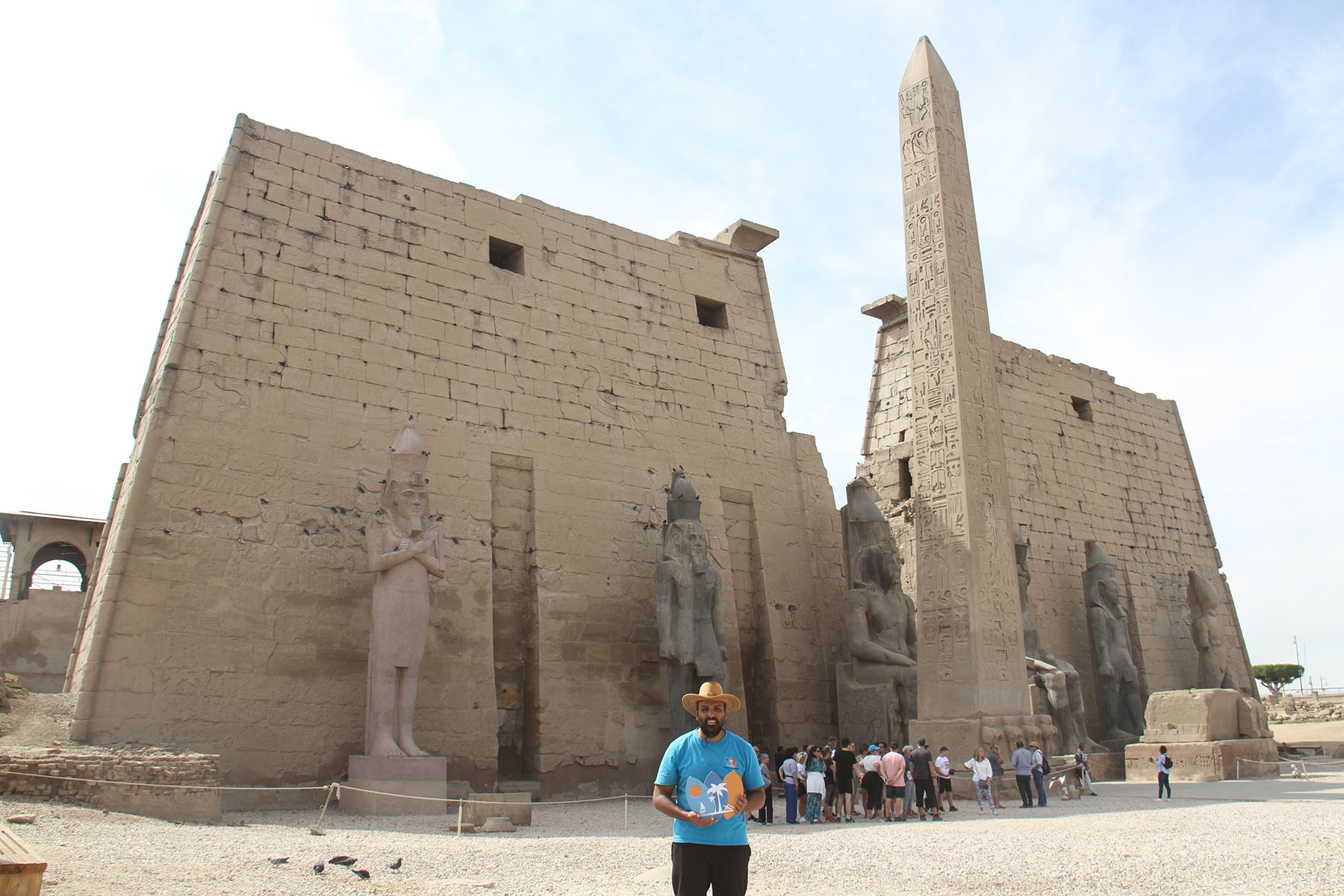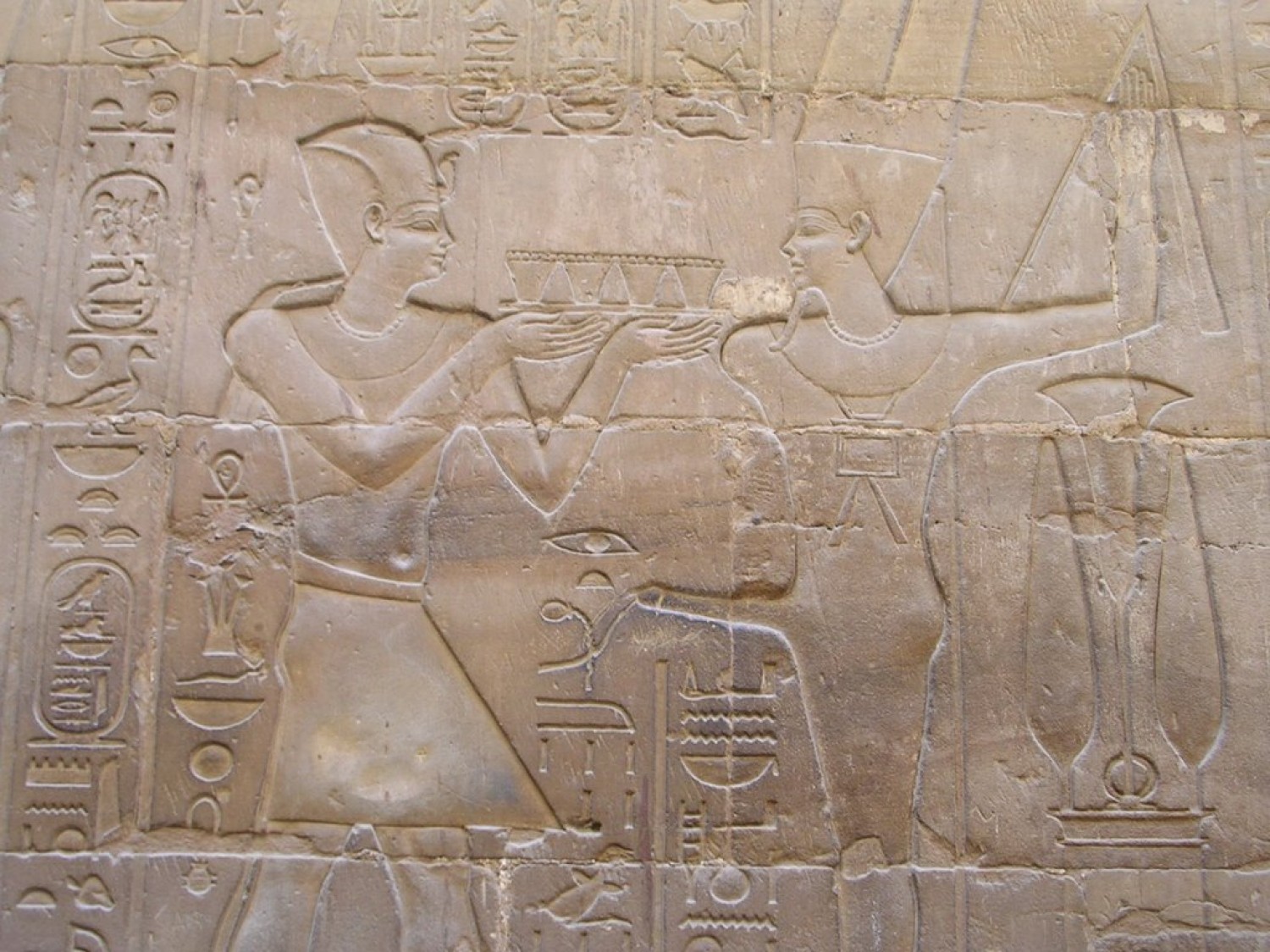Luxor Temple: The Most Famous Temple in Egypt
Jun 2
As the sun rises over the city of Luxor in Egypt, the glimmering golden stones of the Luxor Temple come to life. An enchanting symbol of ancient civilization, this temple stands as one of the country's most famous and visited landmarks. With its grandeur of architecture, rich history, and captivating secrets, it's no wonder why Luxor Temple continues attracting tourists worldwide. If you're planning a trip to Egypt, this temple is a must-see destination that will take your breath away. Come with us on a journey through time and discover the wonders of Luxor Temple.

Luxor Temple: A Symbol of Ancient Egyptian Architecture and History
Luxor Temple is a true masterpiece of ancient Egyptian architecture and history. This temple was constructed thousands of years ago and still stands strong today as a symbol of the country's rich cultural heritage. As you enter its entrance, you are transported to a time of pharaohs and gods, where every inch of the temple carries deep meaning and significance. From the Avenue of Sphinxes to the multiple chapels and courts, the Luxor Temple is a must-see if you're interested in ancient history and architecture.
Walking through this temple, you will be amazed by its sheer size and the intricate details etched into every surface. It is home to the largest collection of Egyptian artefacts on exhibit in Western North America, giving visitors a glimpse into the ancient world. The temple is dedicated to the deities Mut, Khonsu, and Amun, and it was built over a period of several years by multiple pharaohs. The entrance is over 200 feet wide, and the temple contains ten sections, each with unique features and characteristics.
One of the main functions of the Luxor Temple was to promote the fertility of the pharaohs and the god Amun-Re. This was done through a yearly event called the Opet festival, during which statues of the temple's deities would be paraded down the Nile from nearby Karnak. The festival was an important part of ancient Egyptian culture and religion, and it helped to cement the relationship between the pharaohs and their gods.
Despite being thousands of years old, the Luxor Temple still stands tall today, attracting visitors worldwide. Its mud bricks walls were constructed to symbolize the separation between humans and the gods. The temple represents a true masterpiece of ancient engineering and architecture, showcasing the advanced knowledge and achievements of the ancient Egyptians.
Visiting the Luxor Temple is an experience unlike any other. Its rich history, intricate details, and sheer size make it a true masterpiece of ancient Egyptian architecture. As you walk through its halls and marvel at its beauty, you will be transported back to a land of pharaohs and gods, where every inch of the temple carries deep meaning and significance. If you're interested in ancient history and architecture, the Luxor Temple is a must-see attraction you won't want to miss. [1][2]
Walking through this temple, you will be amazed by its sheer size and the intricate details etched into every surface. It is home to the largest collection of Egyptian artefacts on exhibit in Western North America, giving visitors a glimpse into the ancient world. The temple is dedicated to the deities Mut, Khonsu, and Amun, and it was built over a period of several years by multiple pharaohs. The entrance is over 200 feet wide, and the temple contains ten sections, each with unique features and characteristics.
One of the main functions of the Luxor Temple was to promote the fertility of the pharaohs and the god Amun-Re. This was done through a yearly event called the Opet festival, during which statues of the temple's deities would be paraded down the Nile from nearby Karnak. The festival was an important part of ancient Egyptian culture and religion, and it helped to cement the relationship between the pharaohs and their gods.
Despite being thousands of years old, the Luxor Temple still stands tall today, attracting visitors worldwide. Its mud bricks walls were constructed to symbolize the separation between humans and the gods. The temple represents a true masterpiece of ancient engineering and architecture, showcasing the advanced knowledge and achievements of the ancient Egyptians.
Visiting the Luxor Temple is an experience unlike any other. Its rich history, intricate details, and sheer size make it a true masterpiece of ancient Egyptian architecture. As you walk through its halls and marvel at its beauty, you will be transported back to a land of pharaohs and gods, where every inch of the temple carries deep meaning and significance. If you're interested in ancient history and architecture, the Luxor Temple is a must-see attraction you won't want to miss. [1][2]

A Place of Coronation for Pharaohs: History of Luxor Temple
As you walk through the gates of the Luxor Temple, you'll be transported back through the ages to the majestic world of the Ancient Egyptians. Discover the history of this incredible site, which has been the site of coronations for over 3,000 years. With its soaring archways, intricate carvings, and towering statues of pharaohs, it's no wonder Luxor Temple is one of the most famous temples in Egypt. This vast and sprawling temple complex tells the story of a powerful civilization that left an indelible mark on the world.
At the heart of Luxor Temple lies the sanctum sanctorum, the innermost sanctuary once home to the statue of Amun. Constructed over 3,000 years ago by Amenhotep III, the ninth pharaoh of the Eighteenth Dynasty, Luxor Temple was expanded and renovated over the centuries by various pharaohs and rulers. The temple is considered used for coronations and other important religious and political events. As you explore the temple complex, you'll see evidence of its long history, from the carvings of Ramesses II to the graffiti left by Napoleon's soldiers.
One of the standout features of Luxor Temple is its Avenue of Sphinxes, a long, wide pathway lined with sphinx statues that once linked the temple to the Karnak complex. The Avenue of Sphinxes stretches almost two miles and must have been an awe-inspiring sight in its heyday. Today, visitors can walk along the avenue and imagine themselves in the shoes of pharaohs and priests who once walked there.
Despite its age, Luxor Temple is incredibly well-preserved, thanks partly to the efforts of archaeologists, conservationists, and historians who have worked to protect and restore the site over the centuries. While you're there, admire the stunning carvings and murals that decorate the temple walls, depicting scenes from everyday life in Ancient Egypt and stories of the gods and goddesses.
Visiting Luxor Temple is a once-in-a-lifetime experience that you'll never forget. With its massive columns, soaring archways, and incredible history, it's easy to see why it's the most famous temple in Egypt. Whether you're a seasoned traveller or a first-time visitor to the country, this incredible site should not be missed. As you stand in the shadow of the towering statues of pharaohs, you'll be reminded of the incredible legacy of the Ancient Egyptians and the enduring power of their culture. [3][4]
At the heart of Luxor Temple lies the sanctum sanctorum, the innermost sanctuary once home to the statue of Amun. Constructed over 3,000 years ago by Amenhotep III, the ninth pharaoh of the Eighteenth Dynasty, Luxor Temple was expanded and renovated over the centuries by various pharaohs and rulers. The temple is considered used for coronations and other important religious and political events. As you explore the temple complex, you'll see evidence of its long history, from the carvings of Ramesses II to the graffiti left by Napoleon's soldiers.
One of the standout features of Luxor Temple is its Avenue of Sphinxes, a long, wide pathway lined with sphinx statues that once linked the temple to the Karnak complex. The Avenue of Sphinxes stretches almost two miles and must have been an awe-inspiring sight in its heyday. Today, visitors can walk along the avenue and imagine themselves in the shoes of pharaohs and priests who once walked there.
Despite its age, Luxor Temple is incredibly well-preserved, thanks partly to the efforts of archaeologists, conservationists, and historians who have worked to protect and restore the site over the centuries. While you're there, admire the stunning carvings and murals that decorate the temple walls, depicting scenes from everyday life in Ancient Egypt and stories of the gods and goddesses.
Visiting Luxor Temple is a once-in-a-lifetime experience that you'll never forget. With its massive columns, soaring archways, and incredible history, it's easy to see why it's the most famous temple in Egypt. Whether you're a seasoned traveller or a first-time visitor to the country, this incredible site should not be missed. As you stand in the shadow of the towering statues of pharaohs, you'll be reminded of the incredible legacy of the Ancient Egyptians and the enduring power of their culture. [3][4]

Design Techniques Used in Luxor Temple: Illusions and Symbolism
Luxor Temple is one of the most famous and historic temples in Egypt. Its architecture is renowned for its unique design techniques, particularly illusions and symbolism. If you plan a trip to Luxor, you must see this masterpiece of ancient architecture. Here is a guide on the design techniques used in Luxor Temple with some interesting facts about them.
Firstly, Luxor Temple used symbolism to create illusions in its design. For example, the sanctuary in the temple was shaped like an Anubis Jackal, representing the god Anubis. Using such illusions gave the impression that the temple was larger and more significant than it was. Additionally, columns of different sizes and heights were designed to look the same, creating a visual perspective that made the temple seem even grander.
Another design technique used in Luxor Temple was illusionism. The temple's layout and spaces were crafted using techniques that made them appear bigger, smaller, or taller than they were. This technique is most evident in the visual perspectives of the temple, which are created through the manipulation of light and shadow.
The Luxor Temple is also renowned for its unique design elements, such as open and closed papyrus flowers in the Hypostyle Hall. The Hall contains 134 massive columns created in the shape of these flowers, designed to support the weight of the temple roof. Using these columns is considered an engineering marvel, as they can sink the entire Hypostyle Hall under desert soil.
Luxor Temple is a masterpiece of ancient architecture, admired for its unique design techniques that combine symbolism and illusionism. It is illusions and hidden meanings make Luxor Temple so special and a must-see for anyone interested in ancient Egyptian history. So, when you visit Luxor, take in the Temple's remarkable design elements and uncover its fascinating secrets. [5][6]
Firstly, Luxor Temple used symbolism to create illusions in its design. For example, the sanctuary in the temple was shaped like an Anubis Jackal, representing the god Anubis. Using such illusions gave the impression that the temple was larger and more significant than it was. Additionally, columns of different sizes and heights were designed to look the same, creating a visual perspective that made the temple seem even grander.
Another design technique used in Luxor Temple was illusionism. The temple's layout and spaces were crafted using techniques that made them appear bigger, smaller, or taller than they were. This technique is most evident in the visual perspectives of the temple, which are created through the manipulation of light and shadow.
The Luxor Temple is also renowned for its unique design elements, such as open and closed papyrus flowers in the Hypostyle Hall. The Hall contains 134 massive columns created in the shape of these flowers, designed to support the weight of the temple roof. Using these columns is considered an engineering marvel, as they can sink the entire Hypostyle Hall under desert soil.
Luxor Temple is a masterpiece of ancient architecture, admired for its unique design techniques that combine symbolism and illusionism. It is illusions and hidden meanings make Luxor Temple so special and a must-see for anyone interested in ancient Egyptian history. So, when you visit Luxor, take in the Temple's remarkable design elements and uncover its fascinating secrets. [5][6]
:max_bytes(150000):strip_icc()/GettyImages-143778877-5a01a32313f129003718e4fa.jpg)
The Theban Triad: The Gods Worshipped at Luxor Temple
Luxor Temple, also known as the Temple of Luxor, is one of the most famous temples in Egypt. It is located on the east bank of the Nile River in Luxor and is considered a great open museum. One of the most important parts of Luxor Temple is the Theban Triad, consisting of the gods Amon-Ra, his wife Mut, and their son Jonsu. The temple is dedicated to their worship, and it was built by the order of Amenophis III in 1400 BCE. The construction was later restarted during the period of Tutankhamon, and some new constructions were added during the Ptolemaic dynasty. Various other rulers added their touches, making the temple a reflection of ancient Egyptian history.
The Temple of Luxor is the second-largest temple in Egypt, covering an area of 260 meters long and 50 meters wide. A pylon built by Ramses II marks its entrance. Six giant statues of Ramses II are also present, sitting on their lathe and surrounding the entrance. There were originally two obelisks of Ramses II, but one was moved to France in 1833. The remaining obelisk is 25 meters high and stands on the left. Another notable feature of the temple is a colonnade leading to the Amenophis III court. The walls surrounding the temple feature chapels and ceremonial scenes, providing insight into ancient Egyptian religious customs.
Luxor Temple was the site of the feast of Opet, where the god Amon was transferred by a sacred boat from the Temple of Karnak to the Temple of Luxor. This festivity was celebrated during the second and third months of the flood season. Over time, the temple and its surroundings were used as a legionary fortress by the Romans and as an area of Christian worship. Despite these different uses, the temple has stood the test of time and has become a testament to ancient Egypt's religious beliefs and architectural feats.
One of the most interesting aspects of Luxor Temple is the use of symbolism and illusionism in its construction. For example, the two obelisks flanking the entrance were not the same height, but they were designed to create an illusion that they were. The temple layout created an effect that made them appear to be of equal height, enhancing the illusion and emphasizing the distance and heights between them. Overall, symbolism and illusionism made the temple an even more awe-inspiring structure.
Luxor Temple is a testament to the importance of religion in ancient Egyptian culture. Its massive size, intricate design, and use of symbolism have made it one of the most famous temples in Egypt. The Theban Triad, consisting of Amon-Ra, Mut, and Jonsu, has been worshipped there for centuries, making it a holy site for many. Whether you are interested in history, architecture, or religion, Luxor Temple is worth a visit! [7][8]
The Temple of Luxor is the second-largest temple in Egypt, covering an area of 260 meters long and 50 meters wide. A pylon built by Ramses II marks its entrance. Six giant statues of Ramses II are also present, sitting on their lathe and surrounding the entrance. There were originally two obelisks of Ramses II, but one was moved to France in 1833. The remaining obelisk is 25 meters high and stands on the left. Another notable feature of the temple is a colonnade leading to the Amenophis III court. The walls surrounding the temple feature chapels and ceremonial scenes, providing insight into ancient Egyptian religious customs.
Luxor Temple was the site of the feast of Opet, where the god Amon was transferred by a sacred boat from the Temple of Karnak to the Temple of Luxor. This festivity was celebrated during the second and third months of the flood season. Over time, the temple and its surroundings were used as a legionary fortress by the Romans and as an area of Christian worship. Despite these different uses, the temple has stood the test of time and has become a testament to ancient Egypt's religious beliefs and architectural feats.
One of the most interesting aspects of Luxor Temple is the use of symbolism and illusionism in its construction. For example, the two obelisks flanking the entrance were not the same height, but they were designed to create an illusion that they were. The temple layout created an effect that made them appear to be of equal height, enhancing the illusion and emphasizing the distance and heights between them. Overall, symbolism and illusionism made the temple an even more awe-inspiring structure.
Luxor Temple is a testament to the importance of religion in ancient Egyptian culture. Its massive size, intricate design, and use of symbolism have made it one of the most famous temples in Egypt. The Theban Triad, consisting of Amon-Ra, Mut, and Jonsu, has been worshipped there for centuries, making it a holy site for many. Whether you are interested in history, architecture, or religion, Luxor Temple is worth a visit! [7][8]

Opet Festival: Celebration of Fertility at Luxor Temple
Luxor Temple is considered the most famous temple in Egypt and is widely known to host the annual Opet Festival. The Opet Festival was celebrated during the second month of the Nile flood season to promote fertility in Ancient Egyptian society. During the festival, the god Amun, his wife, and his son made a ritual journey from their shrines in Karnak to Luxor Temple, which was the final destination of the festival. The festival was especially important as it promoted the Pharaoh's fertility, who was believed to be the spiritual offspring of Amun-Re and served as the intermediary between the gods and Egypt.
The Opet Festival was celebrated annually during the New Kingdom, and its duration varied from 11 days under the reign of Amenhotep III to 24 days during the reign of Ramses III. The festival incorporated the ritual procession of a ceremonial boat carrying the cult statue of Amun-Re. Moreover, a ritual marriage ceremony would take place between the Pharaoh and Amun-Re, and the Pharaoh underwent a re-crowning ceremony emphasising the Pharaoh's fertile nature and legitimising his divine right to rule.
The Opet Festival's historical significance lies in promoting the Pharaoh's fertility in Ancient Egyptian society, which was believed to be essential for the continued prosperity of Egypt. Moreover, it served as a means of appeasing the gods, perceived as the source of all-natural events. The festival thus reinforced the perceived symbiotic relationship between gods and humans in Ancient Egyptian society.
The procession route of the Opet Festival between Karnak and Luxor Temple varied and sometimes took place along the Avenue of Sphinxes, which was nearly two miles long. At other times, the sacred statue travelled on a specially made bark covered with gold and decorated with a ram's head sacred to the god. The images would be returned to their shrines in Karnak in a second public appearance that closed the festival.
The survival of the ancient Opet Festival's cult is evident in the present-day celebration of Sheikh Yūsuf al-Haggāg, an Islamic holy man whose boat is carried around Luxor amid a popular celebration. His mosque stands in the northeastern corner of the first courtyard of Luxor Temple, over the foundations of a church. The festival's scenes and their significance are carved in the Colonnade of the Temple of Amenhotep III's reign, where priests carry statues of Amon, Mut, and Khons in barks onto river barges and, finally, onto Luxor. [9][10]
The Opet Festival was celebrated annually during the New Kingdom, and its duration varied from 11 days under the reign of Amenhotep III to 24 days during the reign of Ramses III. The festival incorporated the ritual procession of a ceremonial boat carrying the cult statue of Amun-Re. Moreover, a ritual marriage ceremony would take place between the Pharaoh and Amun-Re, and the Pharaoh underwent a re-crowning ceremony emphasising the Pharaoh's fertile nature and legitimising his divine right to rule.
The Opet Festival's historical significance lies in promoting the Pharaoh's fertility in Ancient Egyptian society, which was believed to be essential for the continued prosperity of Egypt. Moreover, it served as a means of appeasing the gods, perceived as the source of all-natural events. The festival thus reinforced the perceived symbiotic relationship between gods and humans in Ancient Egyptian society.
The procession route of the Opet Festival between Karnak and Luxor Temple varied and sometimes took place along the Avenue of Sphinxes, which was nearly two miles long. At other times, the sacred statue travelled on a specially made bark covered with gold and decorated with a ram's head sacred to the god. The images would be returned to their shrines in Karnak in a second public appearance that closed the festival.
The survival of the ancient Opet Festival's cult is evident in the present-day celebration of Sheikh Yūsuf al-Haggāg, an Islamic holy man whose boat is carried around Luxor amid a popular celebration. His mosque stands in the northeastern corner of the first courtyard of Luxor Temple, over the foundations of a church. The festival's scenes and their significance are carved in the Colonnade of the Temple of Amenhotep III's reign, where priests carry statues of Amon, Mut, and Khons in barks onto river barges and, finally, onto Luxor. [9][10]
